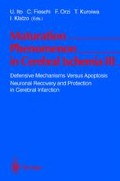Summary
In the context of genetic control over cell death in brain following ischemia, we studied the functional significance of the newly described caspase-3 member of the interleukin-converting enzyme (ICE) protease family. At both message and protein levels, this gene’s product was upregulated in selectively vulnerable regions following ischemia. Coincident with cell death, the precursor protein was proteolytically cleaved and the protease activity increased. In regions of neuronal death, PARP cleavage was demonstrated. Inhibition of caspase-3 protease activity decreased both neuronal death and deoxyribonucleic acid (DNA) fragmentation (TUNEL labeling) and increased survival in selectively vulnerable brain regions 1 week after ischemia. These data support the view that caspase-3 protease is an inducible modulator of cell death in ischemic brain.
Access this chapter
Tax calculation will be finalised at checkout
Purchases are for personal use only
Preview
Unable to display preview. Download preview PDF.
References
Bredesen DE (1995) Neural apoptosis. Ann Neural 38: 839–851
Chen J, Graham SH, Nakayama M, Zhu RL, Jin K, Stetler RA, Simon RP (1997) Apoptosis repressor genes bcl-2 and bcl-x-long are expressed in the rat brain following global ischemia. J Cereb Blood Flow Metab 17: 2–10.
Chen J, Zhu RI., Nakayama M, Kawaguchi K, Jin K, Stetler RA, Simon RP, Graham SH (1996) Expression of the apoptosis-effector gene, Bax, is up-regulated in vulnerable hippocampal CAI neurons following global ischemia. J Neurochem 67: 64–71
Enari M, Talanian RV, Wong WW, Nagata S (1996) Sequential activation of ICE-like and CPP32-like proteases during Fas-mediated apoptosis. Nature 380: 723–726
Fernandes-Alnemri T, Litwack G, Alnemri ES (1994) CPP32, a novel human apoptotic protein with homology to Caenorhabditis elegans cell death protein Ced-3 and mammalian interleukin-1 beta-converting enzyme. J Biol Chem 269: 30761–30764
Gillardon F, Bottiger B, Schmitz B, Zimmermann M, Hossmann KA (1997) Activation of CPP-32 protease in hippocampal neurons following ischemia and epilepsy. Brain Res Mol Brain Res 50: 16–22
Hara H, Friedlander RM, Gagliardini V, Ayata C, Fink K, Huang Z, Shimizu-Sasamata M, Yuan J, Moskowitz MA (1997) Inhibition of interleukin lbeta converting enzyme family proteases reduces ischemic and excitotoxic neuronal damage. Proc Natl Acad Sci U S A 94: 2007–2012
Juan TS, McNiece IK, Jenkins NA, Gilbert DJ, Copeland NG, Fletcher FA (1996) Molecular characterization of mouse and rat CPP32 beta gene encoding a cysteine protease resembling interleukin-1 beta converting enzyme and CED-3. Oncogene 13: 749–755
Ni B, Wu X, Du Y, Su Y, Hamilton-Byrd E, Rockey PK, Rosteck P Jr., Poirier GG, Paul SM (1997) Cloning and expression of a rat brain interleukin-lbeta-converting enzyme (ICE)-related protease (IRP) and its possible role in apoptosiis of cultured cerebellar granule neurons. J Neurosci 17: 1561–1569
Srinivasula SM, Fernandes-Alnemri T, Zangrilli J, Robertson N, Armstrong RC, Wang L, Trapani JA, Tomaselli KJ, Litwack G, Alnemri ES (1996) The Ced-3/interleukin 1beta converting enzyme-like homolog Mch6 and the lamin-cleaving enzyme Mch2alpha are substrates for the apoptotic mediator CPP32. J Biol Chem 271: 27099–27106
Tewari M, Quan LT, O’Rourke K, Desnoyers S, Zeng Z, Beidler DR, Poirier GG, Salvesen GS, Dixit VM (1995) Yama/CPP32 beta, a mammalian homolog of CED-3, is a CrmA-inhibitable protease that cleaves the death substrate poly(ADP-ribose) polymerase. Cell 81: 801–809
Editor information
Editors and Affiliations
Rights and permissions
Copyright information
© 1999 Springer-Verlag Berlin Heidelberg
About this paper
Cite this paper
Chen, J., Simon, R.P. (1999). The Role of Caspase-3-like Protease in the Hippocampus After Transient Global lschemia. In: Ito, U., Fieschi, C., Orzi, F., Kuroiwa, T., Klatzo, I. (eds) Maturation Phenomenon in Cerebral Ischemia III. Springer, Berlin, Heidelberg. https://doi.org/10.1007/978-3-642-58602-6_5
Download citation
DOI: https://doi.org/10.1007/978-3-642-58602-6_5
Publisher Name: Springer, Berlin, Heidelberg
Print ISBN: 978-3-540-65023-2
Online ISBN: 978-3-642-58602-6
eBook Packages: Springer Book Archive

